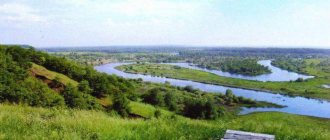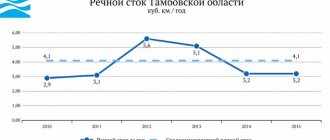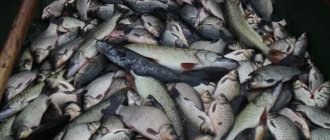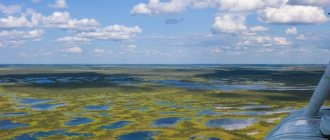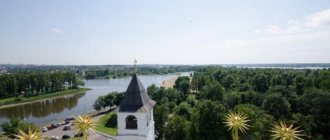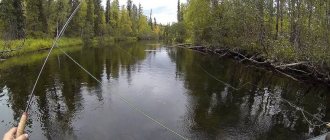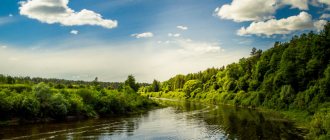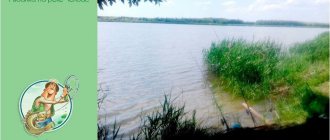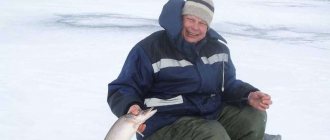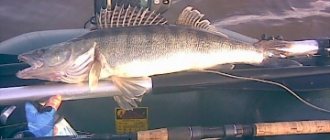Briefly about the reservoir.
The beginning of the Khoper River is 12 springs located near the village of Poperechnoye, which is located in the Penza region. The total length of the river is approximately 1000 km. This is the leftmost tributary of the Don, which passes through the Penza, Saratov, Voronezh, and Volgograd regions. Many tributaries flow into it; the main rivers are the Vorona, Buzluk, and Savala. The total area of Khopra is about 61 thousand km. The river has an average width of 40 m, and in some places it reaches 100 m and even 200 m. The reservoir is not deep, mostly 1.5 m, in rare places the depth reaches 10 m.
There are small towns and villages near the reservoir, the main ones being: • Balashov; • Uryupinsk; • Povorino; • Borisoglebsk; • Novokhopyorsk.
general characteristics
The catchment area exceeds 61 thousand square meters.
km. Khopr's diet is mainly snow. The water temperature throughout the year ranges from +3 degrees (December, January, February, March) to +22-23 (July, August). In the hot summer, the Khoper can warm up to + 25. In mid-late November, the river becomes covered with ice. Ice drift begins in early April. The spring flood lasts about a month, during which time the water level rises to 5 meters. In July, the Khoper becomes shallow, and sandy islands protrude above the water surface. The bottom is predominantly sandy, in some areas clayey.
The depth of the river varies: from 0.5 to 1.5 meters on the rifts and up to 3-12 meters on the reaches. Closer to the source, the width of the channel is only 10-12 m, and in the middle and lower reaches the river widens to 70-100 m.
In the upper reaches of the Khoper, its waters flow among flat meadow steppes, then the steppe gives way to floodplain deciduous forests, in the middle reaches along the banks of the Khoper there is a pine forest, and oak groves grow closer to the mouth. The width of the floodplain is 2-4 km, with each new tributary the floodplain expands, at the mouth of the Karachan its width reaches 10 km. There are lakes to the right and left of the riverbed.
Features of the Khoper River
In late autumn the river freezes until the weather warms up in April. The flood is accompanied by an increase in the water level by 5 m in the main part of the river, and in the lowlands the level can rise by 8 m. This lasts approximately 2 - 2.5 months. In summer, the river becomes shallow, revealing numerous spits and islands. The rise of water begins with the onset of autumn during heavy and frequent rains.
In the Khopra floodplain there are many lakes, some of which stretch for several kilometers. The area below Borisoglebsk is considered the most hilly. The right bank is high with many hills and ravines. The left one is lower with many sandy beaches, and there are many fallen trees in the riverbed. Along the entire length of the river there are mixed forests, and in the lower part they are mainly oak. The forests contain wild pears, cherries and apple trees.
The most favorable time for vacation is in May and August, when there are no large concentrations of mosquitoes and there is no intense heat. The water in Khopra is one of the cleanest in Russia, and you can see the bottom at a depth of up to 2 m. In the upper part of the river you can see little shipping. There are several small dams on the river.
About fish.
Khoper is rich in various species of fish, among which you can find: catfish, pike, perch, bream, crucian carp, roach, bleak, pike perch, ide, chub, asp and other smaller fish. Large pike can be found in the Saratov region. Mostly it reaches a weight of 1 kg or more. The most popular among fishermen is the area near the village of Vasilievka, which is located below the city of Borisoglebsk in the Voronezh region. The bite will be successful from the beginning of September until the first frost. At this time, there is no suffocating summer heat, and the fish begins to gain weight before wintering and the bite is more frequent.
Khoper
The Khoper River is the largest left tributary of the Don and the second largest among all tributaries of the Don, second only to the Seversky Donets. The Khoper River flows through the territory of the Penza, Saratov, Voronezh and Volgograd regions of the Russian Federation. According to UNESCO, it is one of the most environmentally friendly rivers in Europe. According to legend, the river got its name from the name of a miller who combined the water of 12 springs into one stream and built a water mill, where he ground grain for his fellow villagers for many years. There is even a monument to grandfather Khoper at the source of the river. The mill is also shown to tourists, but the guides usually find it difficult to answer whether it is the same mill. The source of the river is located in the Penza region on the Volga upland. The river flows in a southwestern direction and near the village of Ust-Khoperskaya it flows into the Don. The Khopra basin is located on the Russian Plain, which largely determines the flow and character of the river and its banks. The average depth of Khopra is 7-8 meters. Its length is almost 1000 km. The width in the middle reaches ranges from 20 to 35 meters. In the river valley there are wetlands and lakes. In the lower reaches, the width of the channel reaches 70-120 meters, and its depth increases to 10 meters.
The flow of the river has a large number of sandy and clayey rifts; in the riverbed there are rocky areas, whirlpools, and debris of snags. There are many ditches and oxbow lakes along the banks, many of which are connected to the main channel only during floods. In many places the river bed forms bends and backwaters. The banks of the river are covered with dense vegetation. The right bank is steep and rocky. Along the left bank, flat areas are interrupted by elevated and sometimes steep areas. There are quite a few access points to the water. So it’s better to go fishing by boat in order to reach secluded places rich in fish by water. The river is fed predominantly by snow. The duration of the spring flood is more than one and a half months. The river opens up from ice at the beginning of April and freezes at the end of November. During warm winters, ice cover can be unstable. The low water level with the lowest water level is established by the beginning of July. Periodically it may be interrupted by rain floods. A stable rise in water is expected in the autumn months, when cold weather does not contribute to active evaporation. The main tributaries of the Khoper River are the Vorona, Olshanka, Kamzolka, Serdoba, Pasha, Dobraya, Buzluk, Akulovka and many others. In the lower reaches of the Khoper there is the Khopersky Nature Reserve, as well as the Almazovsky and Arkadaksky reserves, where a number of rare species of wild animals are under state protection.
Origin of the name of the river “Khoper”
An ancient legend says that the Polovtsian Khan Tokai had a beautiful daughter, her name was Vorona. All the boys in the area were in love with her. One day, the evil Tatars came to the lands of the Polovtsians, killed many men and women, and took some into captivity. Only Crow managed to escape. The Tatar warriors Chembar, Vyazhlya and Karai saddled their fast horses and rushed in pursuit of the beauty. The girl asked for protection from the heroes Lomovis and Burtas, who admired her beauty, but the warriors chickened out, hiding in the forests.
In the Vyatichi tribe there lived a brave young man, his name was Khoper. He helped Crow. The Vyatich girl put the girl on a horse, and they rode off in search of shelter. But the Tatars’ horses are fast, and Khopr and Vorona soon began to catch up. The fugitives reached the mighty Don and asked him for protection. The Don hid everyone securely: he turned the pursuers and the fugitives into rivers. This is how Vorona, Khoper, Vyazhlya, Chembar and Karai appeared in the steppe.
Another legend is not so poetic and talks about an old man named Khoper. One day, under a hill, an old man saw 12 springs gushing out of the ground, took a shovel in his hands and laid out a single channel for the streams. On the river that appeared, he built a water mill, grinding flour for himself and for the people. Since then they began to call this river Khoprom.
Fishing Features
You can get to settlements located along the banks of the Khoper River by roads, by train and by boat. The river is navigable in the section from the city of Novokhopersk to its confluence with the Don. There are many places on the river where there are bridges connecting the right bank with the left. It is almost impossible to get a good catch in places where there are convenient approaches to the river. Firstly, because vacationers gather there during the hot season. And secondly, there is high fishing pressure. But it’s enough to sail a boat just 1 km away from crowded places, cast a fishing rod, and the fishing situation changes for the better. From June to early October, the problem for anglers who prefer bottom gear is the grass that is carried by the current. Without knowing local conditions, it is quite difficult to fish from the shore in close proximity to snag debris. The most catchy places are considered to be backwaters located at the bends of the river, as well as the confluence of large tributaries. Fishing in oxbow lakes and lakes located along the banks of the Khoper can be productive.
Kayaking
Even a novice tourist can go kayaking from the source to the mouth. According to the classification of tourist routes, the Khoper River belongs to category 1 of complexity, that is, the lowest. The best time for rafting is May-September. You can start rafting already in the upper reaches of the river, near the village of Sekretarka (Penza region). There are still small obstacles: flooded trees, destroyed dams, low road bridges, sandbanks. In some areas it is impossible to navigate a kayak on water; you only have to go around the obstacle on land. After the confluence of the Vorona, the Khoper becomes much wider, and nothing prevents rafting.
In places where the channel is wide, the flow is calm and leisurely; As the river narrows, the flow speed increases. Beautiful scenery, convenient parking and swimming areas allow you to fully enjoy an active holiday.
When approaching the Khopersky Nature Reserve, you must remember that the river is closed for rafting on rubber boats and kayaks from March to June. More detailed information can be found by visiting the reserve's website. By the way, the reserve itself offers ecological routes for kayakers throughout its territory.
Fishing on Khoper
A striking example of a reservoir where there is a lot of excellent fish, but how difficult it is to catch them is the Khopra section, below Borisoglebsk near the villages of Vasilievka and Alferovka, in the Voronezh region, where I and my friends traveled a lot, loving these places for interesting fishing.
Excellent depths 4-5m below the city attract with the intrigue of catching large fish, but it is in these holes that the bite is especially capricious, both predator and bream. Due to the dominant depths, which are atypical for Khopr, the fish react very poorly to any rise in water, so during periods of prolonged rains, fishing does not go well, as a rule. The most interesting thing begins with the fall of the spring flood, usually in the second half of June.
The second peak of the bite occurs in the second half of September - early October, but again only when the water is low - just a little something is wrong with the level, everything seems to be “cut off” immediately, especially bream. On other rivers the fish are somehow more responsive to changes in water level, but here they react well only to a fall. Moreover, it is not a fact that as the level rises, whiteness tends to shallower depths.
It happens exactly the opposite. In the pits near Vasilievka, the bottom fish are usually caught from the right access bank, and often simply not reaching the bream (you can see from the echo sounder that the bream are standing above the far edge), only when casting 50 m away do the bites begin. However, long-distance feeder casts may intersect with the interests of trackers, who can hook bottom rigs with wobblers, and you won’t be able to attack too much.
So boat feeder fishing on Khopra is more successful, calmer, and more reliable. Moreover, the echo sounder often notes a greater density of bream on the left bank - an order of magnitude less crowded, where it is more relaxing to fish. In general, with a boat, the bream is king on this section of the river. It is important that the boat does not tie you to any place, but simply provokes you to look for fish when there are no bites. And flocks are often found by poking.
After all, often, at first glance, very promising bottom changes found by an echo sounder do not work at all - for some reason, not only bream, but no fish at all. At the same time, on some flat ground it is possible to detect schools of active bream.
Active search boat strategies are also good with a float rod. At times, retrieving is excellent for catching bream with a long release of the float, especially in fairly deep (4-5 m) riffle areas. Probably, these outbreaks of zhora are associated with the intersection with running flocks. But in any case, the bite wanes everywhere as the water rises, when the bream scatters, staying mostly high above the bottom, and it is not clear how to catch it.
In warm, stable weather, fishing is good even in high water near grassy shores; they are also found here - short grassy spots overgrown with water lilies and about one and a half meters deep. It is impossible to catch large whitefish in such places by swooping, although there may be a lot of crucian carp, rudd and even tench here, and only skillfully caught by local floaters, who feed their places for a long time.
There are enough Khopra and catfish in this area, including trophy ones, as I myself have been convinced of more than once. Moreover, the maximum concentration of this fish is in an area not exceeding 5-6 km, although this does not make life particularly easy for the catfish - everyone knows where the catfish are, but try again! Apparently, the area has been pressed down in recent years, this is clearly noticeable by the fact that the kwok is working less and less.
And good fish are caught less and less by trolling from the end, you have to carefully select certain wobblers, your own unique methods, not forgetting to put your luck in the boat...
As for pike perch, it is ubiquitous; it is caught almost within the boundaries of Borisoglebsk and below. It happens that it’s very cool in late autumn to take it higher than the city, where there is less pressure on fish and the fishing is better. And at other points of the river, the best time for pike perch is pre-winter, when truly trophy specimens weighing 5-7 kg pass by.
City fishing on Sura
Many residents of the regional center prefer to fish in their city on the Sura River, and this is quite justified. City fishing in Penza is valued for its proximity to home. There is no need for lengthy preparations or food supplies; you can always find time for at least a short trip, getting a boost of energy from your favorite activity. If you wish, you can fish at least every day, especially the long summer days, when they catch both before the start of work and after, in time for the evening dawn. Particularly avid fishermen go out even during lunch break, if the body of water is close to work, and manage to catch something.
There are no problems with the road for fishing. There is always a city minibus that will instantly take you to the pond. If it’s close, walk. Many people have recently switched to a bicycle, with which they can easily ride to the river through any “green zones” that are inaccessible to vehicles.
Often they take their spouse, small children, and dog for city fishing, which is not always possible during long trips, especially in cold weather with an overnight stay. It is also encouraging that the rampant poaching within the city is minimal, because it is difficult for poachers to hide among the eyes of the numerous fishing people.
Among urban fishermen, there are loyal fans who disappear year after year in the same places from early spring to pre-winter. At first glance, it may seem that Penza fishing is boring and monotonous. But this is far from true, because in Sura there is a variety of fish:
- som
- bream
- roach
- zander
- crucian carp
- silver bream
- perch
- bleak
- asp
- chub
- ruff
- white-eye
- saberfish
- pike
- ide
The species diversity of fish is so wide that all representatives of the fishing tribe, both “quiet” floaters and feeders, and active spinning fishermen, find something to do. The latter are increasingly using ultralight rods in urban conditions.
Usually they use spinning rods with a length of 2.4-.2.7m with a dough of 0-10g, 2-12g. The tackle is initially suitable for catching small perch and pike. The high sensitivity of light tackle allows you to better feel the careful, delicate wiring, literally “see” the bottom by touching the jig head, and more clearly hear the slightest touch of a large perch on the bait. Perch is most often caught at relatively shallow depths of the Sura, so jig baits fit perfectly into a small rod test, which usually does not exceed 10-12g.
For urban pike, the old classic Atom-2 spinners, Mepps' Cyclops, and Iron Minnow jigs weighing 15-22g are excellent. In the summer, pike may prefer rubber and wobblers, but in the fall, oscillating spoons come to the fore.
Pike perch is also a frequent visitor to the cages of local fishermen. Spinners have rippers and twisters of almost all sizes and colors in their arsenal. There are a variety of models in use, and there are no clear favorites in rubber. The most important thing is to choose the right weight, taking into account the depth and structure of the bottom in the fishing area. On a hard sandy-rocky or clayey bottom, a standard step works without problems, which is also good for pike. On a muddier bottom, fish with a uniform reel, as close to the bottom as possible - in the fall this is more important than ever.
Fans of white fish fishing primarily focus on catching large bream and roach. Thus, until recently, large undergrowth dominated in 700-800. Now the average size of bream is already around a kilogram, occasionally you come across 1.5-2 kg.
Roach often stays closer to the shore on a quiet reverse current; large ones are better caught on a small foam ball. White bream began to appear more often in bycatch, sometimes delighting local fishermen with serial bites of fish weighing 300-500g. In addition to roach, bream and silver bream, ide and chub began to appear more often in the urban section of Sura, which are caught with miniature “zero” spinners and flies.
The wide variety of fish in the river prompted many residents of the regional center to join the ranks of fishermen, and we can say that almost all of Penza is hooked on fishing happiness and pleasure.
